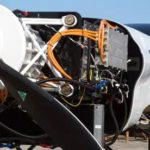Hybrid electric VTOL aviation company SAMAD aerospace has launched its concept for its high-end Personal Air Vehicle (PAV) Q-Starling and revealed its proposals for a worldwide network of tech villages.
Linking elements from both fast jets and VTOL aircraft, a statement by SAMAD said the new aircraft “represented a new pinnacle in future sustainable aircraft design.” Q-Starling combines the benefits of traditional flight with VTOL capabilities. It will seat two passengers and can be flown by pilots with an anticipated appropriate class rating. The aircraft takes its inspiration from classic aircraft such as the Victor, Hawk, Mustang and modern high-end sport cars.
Innovation and entrepreneurship at the heart of the village
Dr Seyed Mohseni, CEO of SAMAD aerospace, based at Cranfield Technology Park, said the network of tech villages would put innovation and entrepreneurship at their centre, helping provide solutions to problems which would help drive both tech and economic development. Mohseni explained: “We were thinking about how we can get together – we have lots of players and new emerging markets in EVTOL.”
“These are challenging technologies to solve and we need to get people together to work together to come up with solid results and the best way is to create an environment that allows people to come together and grow their own businesses and they grasp new opportunities that would emerge as a result of working together.”
He added that the villages would include: “A relatively small airport for testing but also for local flights and VTOL flights.”
He said a residential area would house the majority of people who would be working in the innovation hub and manufacturing facilities. As well as the enterprise facilities, the tech villages would include residential accommodation, hotels, medical centres, schools and community centres.
Nine interlinked centres across the globe
SAMAD is planning nine centres in different regions throughout the globe which will be headquartered in Europe.
“The concept would be similar, but might change from one country to another, but the concept is almost the same. And in this way, for these centers to work together to tap into the global resource of highly skilled engineers and innovative companies can come to the village, who can benefit from it, who can grow and at the same time contribute to the rest of the village.”
Q-Starling powered by hybrid-electric turbo-generator
The Q-Starling will be powered by a hybrid-electric turbo-generator which will provide power for a large diameter hover fan and a fly-by-wire controlled ‘Reaction Control System’ (RCS). The turbo- generator will then provide forward thrust once the aircraft has transitioned from vertical flight.
The aircraft is controlled by a comprehensive electronic flight system and has numerous and extensive safety systems in-built to prevent the aircraft from departing the flight envelope. In keeping with other ultra-light aircraft it also features a ballistic recovery system.
The traditional rudder pedals have been absorbed into the flight system and present the pilot with a simplified side-stick control. The Q-Starling will maintain full authoritative control but having the benefit of a simplified control interface.
Ultra-light carbon fibre construction
The aircraft is expected to have a low entry barrier to private flight with an expected conversion requirement of around 10 hours for the average PPL. The cockpit has been designed to the highest automotive standards of comfort and will include additional transparencies and synthetic vision to enhance situational awareness. All materials used in the aircraft are made of ultra-light carbon fibre giving a higher performance capability and enabling semi-aerobatic manoeuvres due to the increased strength of the composite material and design.
Dr Seyed Mohseni, added: “The Q-Starling will give owners the ultimate luxury in personal hybrid-electric flying. The efficient sustainable Q-Starling will give passengers unparalleled point-to-point mobility options.”
SAMAD aerospace team aims to “make flying as common practice as driving with the ability to move directly from point-to-point.”

